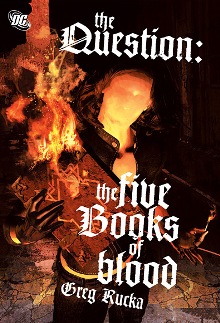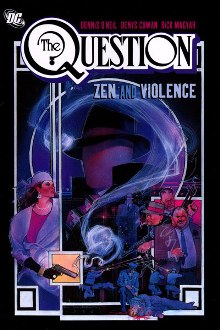One of my all-time favorite runs in comic books, perhaps my all-time favorite, is Denny O’Neil’s 1987 to 1990 series, The Question, his landmark reinterpretation of the Steve Ditko Objectivist “no face” hero, who he transformed into a Zen philosophizing, “no face” hero. The Question was originally Vic Sage, a television reporter with an obnoxious personality who was approached by a former teacher, Professor Aristotle Rodor, to help him thwart an injustice. Rodor had co-developed a fake tissue called “Pseudoderm,” an artificial skin intended to treat wounds, but he abandoned the project when it was discovered that Pseudoderm could be toxic in certain applications. After agreeing to shut down the experiment, his morally-challenged partner instead sold it to a third world country behind his back. Rodor approaches Sage to help apprehend the unscrupulous scientist, and they devise the idea of bonding the Pseudoderm across Sage’s face as a disguise. Thus is born the Question.
Like his previous creation Mr. A, Ditko’s Question is an Objectivist, but also a hero who is not above a bit more brutality than your average superhero, and this emphasis on philosophy and violence finds its way into the DC incarnation. In O’Neil’s first issue, the Question is defeated by his other creation, Lady Shiva, then shot in the head and dumped in the harbor, very much deceased. Shiva, however, recognized a passion for combat in him, and intrigued, rescued and resuscitated him, then took him to kung-fu master Richard Dragon for training, vowing to return a year later to see if he learned anything (and to kill him if he did not). Obviously, he survives the ordeal and returns to his stalking grounds, Hub City. This reborn Question emerges as something of a Zen philosopher, in a synchronicity-laden thirty-six issues (and two annuals and five quarterly specials), that is arguably the best thing Denny O’Neil ever wrote (and this from someone who worshiped his run on Batman). It’s smart stuff, that makes use of the character’s name, look, and trademark curiosity to ask a lot of deep questions, without necessarily providing pat or comfortable answers.
 So it was with some trepidation that I approached Greg Rucka’s The Question: The Five Books of Blood, which features another person inside the No Face mask. I’ve not yet read 52, that gigantic, convoluted macro-series that reestablished the DC Multiverse, but in it, it was revealed that original Question Vic Sage was dying of cancer, and he chose Gotham ex-cop Renee Montoya as his replacement. Renee herself is interesting, as she was created originally for Batman: The Animated Series, (and was then preemptively introduced into the comics before the series debuted, similar to the way that William Dozier asked DC to create the Barbara Gordon Batgirl for his third season of the 60s television series). Before the events of 52, Montoya already had quite a history, including being outed as a lesbian by Two-Face, and quitting the Gotham police department in self-loathing for her inability to shoot someone that she felt deserved it (and for the increasing violence she found the job brought out in her). In other words, she’s someone with a lot of soul-searching to do. Making her a very likely candidate to don the Pseudoderm and fedora.
So it was with some trepidation that I approached Greg Rucka’s The Question: The Five Books of Blood, which features another person inside the No Face mask. I’ve not yet read 52, that gigantic, convoluted macro-series that reestablished the DC Multiverse, but in it, it was revealed that original Question Vic Sage was dying of cancer, and he chose Gotham ex-cop Renee Montoya as his replacement. Renee herself is interesting, as she was created originally for Batman: The Animated Series, (and was then preemptively introduced into the comics before the series debuted, similar to the way that William Dozier asked DC to create the Barbara Gordon Batgirl for his third season of the 60s television series). Before the events of 52, Montoya already had quite a history, including being outed as a lesbian by Two-Face, and quitting the Gotham police department in self-loathing for her inability to shoot someone that she felt deserved it (and for the increasing violence she found the job brought out in her). In other words, she’s someone with a lot of soul-searching to do. Making her a very likely candidate to don the Pseudoderm and fedora.
The Five Books of Blood (a hardcover collecting the comics separately published as Crime Bible: The Five Lessons of Blood) see Montoya in her first full, solo outing as the Question, tracking down the supposed bible of crime, itself another holdover from 52. Suffice to say that the Crime Bible is an infamous and rare text, with only a few copies in the world (and those all varying editions, a la Lovecraft’s Necronomicon). The dark text is the basis for the “religion of crime” that venerates the Biblical Cain as a saint for committing the first murder. Montoya is tracking the book across the world, ostensibly to prevent the spread of its doctrine, but possibly because having read some of it, she is curiously compelled to read more. We open in London, where a lecturing professor who proclaims the book a hoax is revealed to be an ardent believer; to Chevy Chase, Maryland, where a brothel is used to lure American politicians through sex into much deadlier acts; to Gotham City, where Montoya meets up with her former lover, Kate Kane, a.k.a. Batwoman (my favorite section of the book, I should say, and also the one with the best art, courtesy of Matthew Clark); to Hub city and some of the characters from the O’Neil run, and finally to an ultimate confrontation with the Religion of Crime in their secret HQ. Along the way, Montoya is forced to confront her real reasons for wanting this book. Because while it seems that she has been seeking to thwart the “dark faith,” their leader Flay sees a kindred spirit and has really been initiating his replacement (if you get shades of Batman and Ra’s al Ghul, good for you.) Along the way, the Penguin and Commissioner Gordon make cameos, and we get a nice bit with Aristotle Rodor as well, who isn’t sure what he thinks about this new hero in his dead friend’s outfit. And while this isn’t graphic novel Shakespeare, or even as nuanced and philosophical as the Denny O’Neil run, I found I really enjoyed it. I liked Renee as a character, liked her history, her world, and her vibe. I prefer my superheros grounded in some semblance of reality, and I felt this was a nice, solid piece along such lines. But it’s the unexpected ending, which I won’t spoil here, which surprised me the most. Or rather, really left me hanging. Because it was a perfect set up for another story.
 Which is why I was sad to jump on Wikipedia afterward to find out that there wasn’t a follow-up volume, and to learn that Montoya’s next outing as the Question was in Grant Morrison’s Final Crisis, where she is seen hopping around the Multiverse with Captain Marvel, collecting alternate earth versions of Superman, to help defeat defeat Mandrakk the dark monitor. In other words, a character that has always been über-realistic is off parading around the dimensions with super-beings now, to my great disappointment. That has no place in this character’s long history, even allowing for the best-ignored 2005 Rick Veitch mini-series that re-imagines Vic Sage as some sort of urban shaman. Because what The Five Books of Blood did for me more than anything else was whet my appetite for more. I don’t know that the graphic novel really stands alone so much as sets the stage. Which is why I am thrilled to learn of the announcement that Renee Montoya returns as The Question in a series of back up stories beginning in Detective Comics #854, written by Rucka and with art by Blue Beetle’s Cully Hamne. And am I excited about that? No question about it!
Which is why I was sad to jump on Wikipedia afterward to find out that there wasn’t a follow-up volume, and to learn that Montoya’s next outing as the Question was in Grant Morrison’s Final Crisis, where she is seen hopping around the Multiverse with Captain Marvel, collecting alternate earth versions of Superman, to help defeat defeat Mandrakk the dark monitor. In other words, a character that has always been über-realistic is off parading around the dimensions with super-beings now, to my great disappointment. That has no place in this character’s long history, even allowing for the best-ignored 2005 Rick Veitch mini-series that re-imagines Vic Sage as some sort of urban shaman. Because what The Five Books of Blood did for me more than anything else was whet my appetite for more. I don’t know that the graphic novel really stands alone so much as sets the stage. Which is why I am thrilled to learn of the announcement that Renee Montoya returns as The Question in a series of back up stories beginning in Detective Comics #854, written by Rucka and with art by Blue Beetle’s Cully Hamne. And am I excited about that? No question about it!










